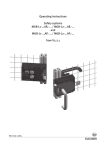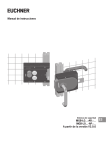Download Operating Instructions MGB-L0…-AR.-… MGB-L0…-AP.
Transcript
Operating Instructions Safety Systems MGB-L0…-AR.-… MGB-L0…-AP.-… from V3.0.0 EN Operating Instructions Safety Systems MGB-L0…-AR.-… and MGB-L0…-AP.-… Contents 1. About this document.............................................................................................. 4 1.1.Scope.............................................................................................................................................4 1.1.1. Notes on older product versions.......................................................................................4 1.2. Target group...................................................................................................................................4 2. 1.3. Key to symbols................................................................................................................................4 1.4. Supplementary documents...............................................................................................................5 Correct use........................................................................................................... 6 2.1. Main differences between MGB-AP and MGB-AR..................................................................................7 3. Description of the safety function........................................................................... 8 4. Exclusion of liability and warranty.......................................................................... 9 5. General safety instructions.................................................................................... 9 6.Function.............................................................................................................. 10 7. System overview................................................................................................. 11 7.1. Interlocking module MGB-L0-….......................................................................................................11 7.2. Handle module MGB-H-…...............................................................................................................11 7.3. Escape release MGB-E-… (optional).................................................................................................11 7.4. Dimension drawing........................................................................................................................12 7.5. Lockout mechanism.......................................................................................................................13 7.6. Escape release (optional)...............................................................................................................14 7.6.1. Preparing escape release ..............................................................................................14 8.Mounting............................................................................................................. 16 8.1. Mounting color cover.....................................................................................................................17 9. Changing actuating direction (here: from right to left)........................................... 19 10. Protection against environmental effects.............................................................. 20 11. Electrical connection........................................................................................... 21 2 11.1. Notes about ..........................................................................................................................22 11.2. Safety in case of faults...................................................................................................................22 11.3. Fuse protection for power supply....................................................................................................22 11.4. Requirements for connection cables................................................................................................23 11.5. Notes on cable laying.....................................................................................................................23 11.6. 11.7. Changing device configuration (using DIP switches)..........................................................................24 11.6.1. Changing system family (AR/AP switching).......................................................................24 Notes on operation with control systems.........................................................................................25 11.8. Terminal assignment and contact description...................................................................................26 11.9. Operation as separate device.........................................................................................................27 (translation of the original operating instructions) 112657-12-01/15 Operating Instructions Safety Systems MGB-L0…-AR.-… and MGB-L0…-AP.-… 11.10. Operation in an AR switch chain......................................................................................................28 11.11. Notes on operation in an AR switch chain........................................................................................29 11.11.1. System times................................................................................................................29 11.11.2. Wiring an AR switch chain...............................................................................................29 11.11.3. Number of devices in the switch chains...........................................................................29 11.11.4. Resetting in switch chains...............................................................................................29 12.Setup.................................................................................................................. 30 13. 12.1. Teach-in operation (only for MGB unicode)........................................................................................30 12.2. Mechanical function test.................................................................................................................30 12.3. Electrical function test....................................................................................................................31 Technical data..................................................................................................... 32 13.1. 14. 15. Typical system times......................................................................................................................33 System states...................................................................................................... 33 14.1. Key to symbols..............................................................................................................................33 14.2. MGB-AR system status table...........................................................................................................34 14.3. MGB-AP system status table...........................................................................................................35 Troubleshooting and assistance............................................................................ 36 15.1. Fault reset.....................................................................................................................................36 15.2. Help on troubleshooting in the Internet............................................................................................36 15.3. Help on mounting in the Internet......................................................................................................36 15.4. Application examples.....................................................................................................................36 16.Service............................................................................................................... 36 17. Inspection and service......................................................................................... 37 18. Declaration of conformity.................................................................................... 38 EN 112657-12-01/15 (translation of the original operating instructions) 3 Operating Instructions Safety Systems MGB-L0…-AR.-… and MGB-L0…-AP.-… 1. About this document 1.1. Scope These operating instructions are valid for all MGB-L0…-AR.-… and MGB-L0…-AP.-…. These operating instructions, the document “Safety information and maintenance” and any enclosed data sheet form the complete user information for your device. Series Version MGB System families …‑AP… L0 (without guard locking) …‑AR… Product versions from V3.0.0 1.1.1. Notes on older product versions Products with lower product versions or without a version number are not described by these operating instructions. Please contact our support team in this case. 1.2. Target group Design engineers and installation planners for safety devices on machines, as well as setup and servicing staff possessing special expertise in handling safety components 1.3. Key to symbols Symbol/depiction AP AR Significance This section applies on operation as MGB-AP This section applies on operation as MGB-AR ON OFF DIP In this section attention must be paid to the DIP switch setting Printed document www t ne er Int Document is available for download at www.euchner.de Document on CD DANGER WARNING CAUTION NOTICE Important! Tip 4 Safety precautions Danger of death or severe injuries Warning about possible injuries Caution Slight injuries possible Notice about possible device damage Important information Tip/useful information (translation of the original operating instructions) 112657-12-01/15 Operating Instructions Safety Systems MGB-L0…-AR.-… and MGB-L0…-AP.-… 1.4. Supplementary documents The overall documentation for this device consists of the following documents: Document title (document number) Contents Safety information and maintenance for safety system MGB‑AR/MGB-AP from V3.0.0 (123151) Basic information about safe setup and maintenance Operating instructions (112657) (this document) Possibly enclosed data sheet Item-specific information about deviations or additions www t ne er Int Brief instructions for teachin operation – MGB-AP/ Brief instructions for teach-in operation MGB-AR (from V2.0.0) (114903) Important! Always read all documents to gain a complete overview of safe installation, setup and use of the device. The documents can be downloaded from www.euchner.de. Enter the document number in the search box for this purpose. EN 112657-12-01/15 (translation of the original operating instructions) 5 Operating Instructions Safety Systems MGB-L0…-AR.-… and MGB-L0…-AP.-… 2. Correct use The system comprises at least one interlocking module MGB-L0-... and one handle module MGB-H... The safety system MGB is an interlocking device without guard locking (type 4). Devices with unicode evaluation possess a high coding level; devices with multicode evaluation feature a low coding level. The interlocking module can be configured with the aid of DIP switches. Depending on the setting, the interlocking module behaves like an AP or AR device (see chapter 2.1. Main differences between MGB-AP and MGB-AR on page 7). More detailed information about the possible settings is available in the chapter 11.6. Changing device configuration (using DIP switches) on page 24. In combination with a movable safety guard and the machine control, this safety component prevents dangerous machine functions from occurring while the safety guard is open. A stop command is triggered if the safety guard is opened during the dangerous machine function. This means: ÌÌStarting commands that cause a dangerous machine function must become active only when the safety guard is closed. ÌÌOpening the safety guard triggers a stop command. ÌÌClosing a safety guard must not cause automatic starting of a dangerous machine function. A separate start command must be issued. For exceptions, refer to EN ISO 12100 or relevant C‑standards. Before the device is used, a risk assessment must be performed on the machine, e.g. in accordance with the following standards: ÌÌEN ISO 13849‑1, Safety of machinery – Safety-related parts of control systems – Part 1: General principles for design ÌÌEN ISO 12100, Safety of machinery – General principles for design – Risk assessment and risk reduction ÌÌIEC 62061, Safety of machinery – Functional safety of safety-related electrical, electronic and programmable electronic control systems Correct use includes observing the relevant requirements for installation and operation, particularly based on the following standards: ÌÌEN ISO 13849‑1, Safety of machinery – Safety-related parts of control systems – Part 1: General principles for design ÌÌEN ISO 14119 (supersedes EN 1088), Safety of machinery – Interlocking devices associated with guards – Principles for design and selection ÌÌEN 60204‑1, Safety of machinery – Electrical equipment of machines – Part 1: General requirements The safety system MGB can only be combined with the intended modules in the MGB system family. On the modification of system components, EUCHNER provides no warranty for function. Interlocking modules with the configuration MGB-AR can be integrated into an AR switch chain. AR Connection of several devices in an AR switch chain is permitted only using devices intended for series connection in an AR switch chain. Check the operating instructions for the related device. Important! ÌÌThe user is responsible for the proper integration of the device into a safe overall system. For this purpose, the overall system must be validated, e.g. in accordance with EN ISO 13849‑2. ÌÌCorrect use requires observing the permissible operating parameters (see chapter 13. Technical data on page 32). ÌÌIf a product data sheet is included with the product, the information on the data sheet applies. 6 (translation of the original operating instructions) 112657-12-01/15 Operating Instructions Safety Systems MGB-L0…-AR.-… and MGB-L0…-AP.-… Table 1: Possible combinations for MGB components Handle module Evaluation unit MGB-H-... from V2.0.0 MGB…AR/AP from V3.0.0 Key to symbols Combination possible 2.1. Main differences between MGB-AP and MGB-AR System family MGB-AP MGB-AR Symbol AP AR Use Optimized for operation in safe control systems. If series connection is not necessary, the number of terminals can be reduced using this system family. Linking of several safety guards on one shutdown path. As a consequence several safety doors can be very simply polled using one evaluation unit or two control system inputs. EN 112657-12-01/15 (translation of the original operating instructions) 7 Operating Instructions Safety Systems MGB-L0…-AR.-… and MGB-L0…-AP.-… 3. Description of the safety function Devices from this series feature the following safety functions: Monitoring of the safety guard position (interlocking device according to EN ISO 14119) ÌÌSafety function: The safety outputs are switched off when the safety guard is open (see chapter 6. Function on page 10). ÌÌSafety characteristics: category, Performance Level, PFHd (see chapter 13. Technical data on page 32). The following applies to devices with emergency stop: Emergency stop (emergency stop device according to EN ISO 13850) ÌÌSafety function: emergency stop function ÌÌSafety characteristics: B10d value (see chapter 13. Technical data on page 32) 8 (translation of the original operating instructions) 112657-12-01/15 Operating Instructions Safety Systems MGB-L0…-AR.-… and MGB-L0…-AP.-… 4. Exclusion of liability and warranty In case of failure to comply with the conditions for correct use stated above, or if the safety instructions are not followed, or if any servicing is not performed as required, liability will be excluded and the warranty void. 5. General safety instructions Safety switches fulfill personal protection functions. Incorrect installation or tampering can lead to fatal injuries to personnel. Check the safe function of the safety guard particularly ÌÌafter any setup work ÌÌafter the replacement of an MGB component ÌÌafter an extended period without use ÌÌafter every fault ÌÌafter any change to the DIP switch setting Independent of these checks, the safe function of the safety guard should be checked at suitable intervals as part of the maintenance schedule. WARNING Danger to life due to improper installation or due to bypassing (tampering). Safety components perform a personal protection function. ÌÌSafety components must not be bypassed, turned away, removed or otherwise rendered ineffective. On this topic pay attention in particular to the measures for reducing the possibility of bypassing according to EN ISO 14119:2013, section 7. ÌÌThe switching operation is only allowed to be triggered by the intended handle module MGB‑H… that is positively fastened to the safety guard. ÌÌPrevent bypassing by means of replacement actuators (only for multicode evaluation). For this purpose, restrict access to actuators and to keys for releases, for example. ÌÌMounting, electrical connection and setup only by authorized personnel possessing the following knowledge: -- specialist knowledge in handling safety components -- knowledge about the applicable EMC regulations -- knowledge about the applicable regulations on occupational safety and accident prevention. Important! Prior to use, read the operating instructions and keep these in a safe place. Ensure the operating instructions are always available during mounting, setup and servicing. EUCHNER cannot provide any warranty in relation to the readability of the CD for the storage period required. For this reason you should archive a printed copy of the operating instructions. You can download the operating instructions from www.euchner.de. EN 112657-12-01/15 (translation of the original operating instructions) 9 Operating Instructions Safety Systems MGB-L0…-AR.-… and MGB-L0…-AP.-… 6. Function Together with a handle module, the interlocking module makes it possible to monitor the position of moving safety guards. The combination also serves as a mechanical door stop at the same time. ON OFF DIP The following switch-on condition applies to the safety outputs FO1A and FO1B (also see chapters 14.2. MGB-AR system status table on page 34 and 14.3. MGB-AP system status table on page 35): Condition Configuration System family MGB-AR MGB-AP No fault in the device TRUE TRUE Safety guard closed TRUE TRUE Bolt tongue inserted in interlocking module TRUE TRUE In case of series connection: Signal available from the upstream switch on the safety inputs FI1A and FI1B In case of separate operation: DC 24 V present at the safety inputs FI1A and FI1B TRUE irrelevant FO1A and FO1B are ON The interlocking module detects the position of the safety guard and the position of the bolt tongue. The bolt tongue in the handle module is moved into and out of the interlocking module by actuating the door handle. 10 (translation of the original operating instructions) 112657-12-01/15 Operating Instructions Safety Systems MGB-L0…-AR.-… and MGB-L0…-AP.-… 7. System overview 7.1. Interlocking module MGB-L0-… 1 2 Key: 1 2 3 4 5 6 7 3 4 7 6 Figure 1: Cover for mechanical release LED indicator DIP switches Terminals X2-X5 Depending on version Cable entry M20x1.5 or plug connector Internal reset Auxiliary marking for maximum permitted mounting distance Notice: Depending on the version, additional controls and indicators may be integrated into the cover and a mounting plate can be included. See enclosed data sheet. 5 Interlocking module MGB-L.--… 7.2. Handle module MGB-H-… 1 Key: 1 Door handle 2 Fold-out lockout mechanism (optional: second, automatically extending lockout mechanism) 3 Locking pin for handle adjustment 4 Locking screws T10 for housing cover 5 Bolt tongue 4 2 2 3 5 Notice: Depending on the version, a mounting plate can be included. See enclosed data sheet. 4 Figure 2: Handle module MGB-H-… 7.3. Escape release MGB-E-… (optional) 1 2 3 4 5 Key: 1 Door handle 2Setscrew 3Cover 4 Actuation axis 8 x 8 mm (different lengths available) 5 Protective sleeve EN Notice: Depending on the version, a mounting plate can be included. See enclosed data sheet. Figure 3: Escape release MGB-E-… 112657-12-01/15 (translation of the original operating instructions) 11 111 Figure 4: 19,2 15 40 113,5 130 104 AUF OPEN ZU CLOSED 40 Dimension drawing – MGB mounted, without optional mounting plates 289,3 M20x1,5 (4x) 155,3 4 40 8x8 6 ,2 7 7 ,5 10 15,4 73,5 16,5 Handle module 6 ,3 46 Hole pattern 8 9 ,4 86,5 24 Escape release 60 S4 S3 S1 S2 min. max. 37,5 47,5 7,5 8 9 ,4 6 Padlock 10 Detail A Lockout mechanism A Dimensions with plug connector RC18 and automatically extending lockout mechanism (optional) 5 10 15 Interlocking module 19 114 83 40 51 61,5 9 2 ,5 11,5 14,5 21 58,5 40 110 (min. 10) 6 ,6 12 30 7.4. Dimension drawing Operating Instructions Safety Systems MGB-L0…-AR.-… and MGB-L0…-AP.-… (translation of the original operating instructions) 112657-12-01/15 Operating Instructions Safety Systems MGB-L0…-AR.-… and MGB-L0…-AP.-… 7.5. Lockout mechanism If the lockout mechanism is pivoted out/extended, the bolt tongue cannot be extended. The lockout mechanism can be secured with padlocks (see Figure 5). ¨¨ To pivot out, press the grooved part (only possible with bolt tongue retracted). 2 1 Key: 1Padlock ∅ min. 2 mm, ∅ max. 10 mm Notice: You can fit a maximum of 3 locks Ø 8 mm. 2 Automatically extending, second lockout mechanism Padlock ∅ min. 6 mm, ∅ max. 10 mm Figure 5: Lockout mechanism secured with padlock EN 112657-12-01/15 (translation of the original operating instructions) 13 Operating Instructions Safety Systems MGB-L0…-AR.-… and MGB-L0…-AP.-… 7.6. Escape release (optional) The escape release is used to open a safety guard from the inside without tools. Important! ÌÌIt must be possible to operate the escape release manually from inside the protected area without tools. ÌÌIt must not be possible to reach the escape release from the outside. ÌÌThe actuator must not be under tensile stress during manual release. ÌÌThe escape release meets the requirements of Category B according to EN ISO 13849‑1:2008. ÌÌFit escape release such that operation, inspection and service are possible. ÌÌThe actuation axis for the escape release must be inserted min. 10 mm into the handle module. Note the information on the different profile widths in the next chapter. ÌÌAlign escape release axis at right angles to the handle module. See Figure 4 and Figure 7. 7.6.1. Preparing escape release (also see Figure 6: Preparing escape release on page 15) Profile width 14 Length required for actuation axis Which EUCHNER parts are required? Necessary work steps Without plates With mounting plates (4 mm each) D D+13 D+21 30 mm 43 mm 51 mm Standard escape release with 110 mm axis (order no. 100465) Shorten to required length 40 mm 53 mm 61 mm Standard escape release with 110 mm axis (order no. 100465) If necessary extended actuation axis (order no. 106761) Without mounting plates: None With mounting plates: Use long actuation axis and protective sleeve and shorten to required length 45 mm 58 mm 66 mm Standard escape release with 110 mm axis (order no. 100465) and extended actuation axis (order no. 106761) Use long actuation axis and protective sleeve and shorten to required length 50 mm 63 mm 71 mm Standard escape release with 110 mm axis (order no. 100465) and extended actuation axis (order no. 106761) Use long actuation axis and protective sleeve and shorten to required length (translation of the original operating instructions) 112657-12-01/15 Operating Instructions Safety Systems MGB-L0…-AR.-… and MGB-L0…-AP.-… Example with mounting plates: D + 3.5 (+4.2 mm per plate) 182 D + 13 (+4.2 mm per plate) 250 D Protective sleeve 55.5 Mounting plates 58.5 3.5 4.2 4.2 (10) Actuation axis A 3 2 4 B 1 1 2 3 4 Fit door handle. Insert actuation axis. The locking ring A must be in contact with the escape release B. Tighten setscrew to 2 Nm. Fit protective sleeve. Figure 6: Preparing escape release EN 112657-12-01/15 (translation of the original operating instructions) 15 Operating Instructions Safety Systems MGB-L0…-AR.-… and MGB-L0…-AP.-… 8. Mounting WARNING Mounting must be performed only by authorized personnel. With two-wing hinged doors, one of the two door wings additionally must be latched mechanically. Use a rod latch (Item) or a double-door lock (Bosch Rexroth) for this purpose, for example. Important! ÌÌIf installed flush, the switching distance changes as a function of the installation depth and the safety guard material. Operating distance Interlocking module Handle module Flush mounting Operating distance Interlocking module Handle module Surface mounting Tip! ÌÌYou will find an animation on the mounting process at www.euchner.de. ÌÌThe color and labeling of pushbuttons and indicators can be modified. For mounting steps, see Figure 7 and Figure 8 to Figure 13. Install system so that inspection and maintenance are possible. 16 (translation of the original operating instructions) 112657-12-01/15 Operating Instructions Safety Systems MGB-L0…-AR.-… and MGB-L0…-AP.-… 8.1. Mounting color cover Mounting 90° Click! 1 2 3 Removing Color cover 1 2 EN 112657-12-01/15 (translation of the original operating instructions) 17 Operating Instructions Safety Systems MGB-L0…-AR.-… and MGB-L0…-AP.-… 2x M6 1 Nm (6x) Cutout for escape release 4x M6 Tightening torque 6 Nm 0,5 Nm Recommended fixing material: For mounting on the mounting plate: DIN 912‑M6X25-8.8 ZN CYLINDER HEAD SCREW Figure 7: 18 Installation example for door hinged on the right (general view) (translation of the original operating instructions) 112657-12-01/15 Operating Instructions Safety Systems MGB-L0…-AR.-… and MGB-L0…-AP.-… 9. Changing actuating direction (here: from right to left) Important! It is only possible to make this change when the bolt tongue is not extended and an escape release is not yet mounted. As supplied, the handle module is set either for doors hinged on the right or for doors hinged on the left. Based on the example of a handle module for doors hinged on the right this means: ÌÌThe safety guard opens by pressing down the door handle. ÌÌThe system is mounted the other way around for doors hinged on the left. In other words, the safety door opens by pressing up the door handle (see Figure 8). For this reason the actuating direction of the door handle must be changed (see Figure 8 to Figure 13). (similarly on handle modules for doors hinged on the left) 1 OPEN 3 CLOSED 2 2 Unscrew locking screws. 3 Push cover aside. 1 Press door handle up. Figure 8: Changing actuating direction, step 1 Figure 9: Changing actuating direction, steps 2 and 3 3 mm 6 b 4 a 5 7 8 4 Lift the locking pin on the door handle using a screwdriver and hold it in this position. 5 Turn door handle to the right. Figure 10: Changing actuating direction, steps 4 and 5 112657-12-01/15 (translation of the original operating instructions) EN 6 Only if using an escape release: using the hexagon head screw, turn the joint counterclockwise from position (a) to position (b). 7 Close cover. 8 Screw in locking screws and tighten to 0.8 Nm. Figure 11: Changing actuating direction, steps 6 to 8 19 Operating Instructions Safety Systems MGB-L0…-AR.-… and MGB-L0…-AP.-… 3 mm 9 11 10 CLOSED 9 Remove cover and undo hexagon socket screw. AT Reposition the door handle by 90° in clockwise direction and fasten it again. AK Tighten hexagon socket head screw to 3 Nm. Figure 12: Changing actuating direction, steps 9 and OPEN State after repositioning. Figure 13: Changing actuating direction, final state 10. Protection against environmental effects Lasting and correct safety function requires that the system must be protected against foreign bodies such as swarf, sand, blasting shot, etc., which can become lodged in the interlocking and handle modules. For this purpose a suitable installation position should be selected. Cover device during painting work! 20 (translation of the original operating instructions) 112657-12-01/15 Operating Instructions Safety Systems MGB-L0…-AR.-… and MGB-L0…-AP.-… 11. Electrical connection WARNING In case of an error, loss of the safety function through incorrect connection. ÌÌTo ensure safety, both safety outputs (FO1A and FO1B) must always be evaluated. ÌÌThe monitoring outputs must not be used as safety outputs. ÌÌLay the connection cables with protection to prevent the risk of short circuits. CAUTION Risk of damage to equipment or malfunctions as a result of incorrect connection. ÌÌThe inputs on an evaluation unit connected must be positive-switching, as the two outputs on the safety switch deliver a level of +24 V in the switched-on state. ÌÌAll the electrical connections must either be isolated from the mains supply by a safety transformer according EN IEC 61558-2-6 with limited output voltage in the event of a fault, or by other equivalent isolation measures. ÌÌAll electrical outputs must have an adequate protective circuit for inductive loads. The outputs must be protected with a free-wheeling diode for this purpose. RC interference suppression units must not be used. ÌÌPower devices which are a powerful source of interference must be installed in a separate location away from the input and output circuits for signal processing. The cable routing for safety circuits should be as far away as possible from the cables of the power circuits. ÌÌTo prevent EMC problems, it is imperative you follow the chapter 11.5. Notes on cable laying on page 23. Follow EMC notes on devices in the immediate vicinity of the MGB system and their cables. ÌÌIn order to avoid EMC interference, the physical environmental and operating conditions at the installation site of the device must comply with the requirements according to the standard DIN EN 60204-1:2006, section 4.4.2/EMC. Important! ÌÌIf the device does not appear to function when the operating voltage is applied (e.g. green Power LED does not illuminate), the safety switch must be returned to the manufacturer. ÌÌTo ensure the stated degree of protection is achieved, the cover screws must be tightened to a tightening torque of 1 Nm. ÌÌTighten screw for the cover for the mechanical release to 0.5 Nm. EN 112657-12-01/15 (translation of the original operating instructions) 21 Operating Instructions Safety Systems MGB-L0…-AR.-… and MGB-L0…-AP.-… 11.1. Notes about Important! ÌÌFor use and operation as per the requirements 1), a power supply with the feature “for use in class 2 circuits” must be used. The same requirement applies to the safety outputs. Alternative solutions must comply with the following requirements: a)Electrically isolated power supply unit with a max. open-circuit voltage of 30 V/DC and a limited current of max. 8 A. b)Electrically isolated power supply unit in combination with fuse as per UL248. This fuse should be designed for max. 3.3 A and should be integrated into the 30 V DC voltage section. ÌÌThe mounting of conduits directly on the MGB is not allowed. Cables are only allowed to be connected via suitable cable glands. For this purpose use EUCHNER cable gland of type EKPM20/06U. Equivalent cable glands can be used if they are UL-listed (QCRV) and are suitable for the related cable diameter (22 AWG – 17 AWG). 1) Note on the scope of the UL approval: Only for applications as per NFPA 79 (Industrial Machinery). The devices have been tested as per the requirements of UL508 (protection against electric shock and fire). 11.2. Safety in case of faults ÌÌThe operating voltage UB is reverse polarity protected. ÌÌThe safety outputs FO1A/FO1B are short circuit-proof. ÌÌA short circuit between FI1A and FI1B or FO1A and FO1B is detected by the device. ÌÌA short circuit in the cable can be excluded by laying the cable with protection. 11.3. Fuse protection for power supply The power supply must be provided with fuse protection depending on the number of devices and current required for the outputs. The following rules apply: Max. current consumption of an individual device Imax Imax =IUB + IUA + IFO1A+FO1B IUB = Device operating current (80 mA) IUA = Load current of monitoring outputs OD, OT and OI (3 x max. 50 mA) + switches IFO1A+FO1B = Load current of safety outputs FO1A + FO1B (2 x max. 50 mA) AR Max. current consumption of a switch chain Σ Imax Σ Imax =IFO1A+FO1B + n x (IUB + IUA) n =Number of connected devices Current assignment to the fuses Current IUB IFO1A+FO1B Fuse circuit F1 Fuse circuit F2 80 mA (2 x max. 200 mA) IOD,OT,OI = (3 x max. 50 mA) Iswitches = max. 100 mA IUA (per switch) Iindicators = max. 5 mA (per indicator) 22 (translation of the original operating instructions) 112657-12-01/15 Operating Instructions Safety Systems MGB-L0…-AR.-… and MGB-L0…-AP.-… 11.4. Requirements for connection cables CAUTION Risk of damage to equipment or malfunctions as a result of incorrect connection cables. ÌÌOn the usage of other connection components, the requirements in the following table apply. EUCHNER provides no warranty for safe function in case of failure to comply with these requirements. Observe the following requirements with respect to the connection cables: Parameter Value Unit Conductor cross-section min. 0.13 mm² R max. 60 Ω/km C max. 120 nF/km L max. 0.65 mH/km 11.5. Notes on cable laying Lay all MGB connection cables in a common cable harness. MGB-L.-... UB 0V UA 0V FI1A/ FI1B FO1A/ FO1B PLC + 24 V DC 0V cabinet Important: lay cables in a common harness Figure 14: Stipulated cable laying EN 112657-12-01/15 (translation of the original operating instructions) 23 Operating Instructions Safety Systems MGB-L0…-AR.-… and MGB-L0…-AP.-… 11.6. Changing device configuration (using DIP switches) Tip! You will find an animation on device configuration at www.euchner.de. DIP switches The devices can be configured using the DIP switches. The following settings are possible: ÌÌChanging system family (AR/AP switching) 1 Position of the switches Item Description 1 DIP switches 2 Sticker with factory setting 2 Function of the switches Important! ON DIP switches 3, 4 and 6 must be set to “off” position. 1 2 3 4 5 6 Detail Switch Function A 1+2 on: Device is operated as AP system A B C D off: Device is operated as AR system B 3+4 No function C 5 on: Configuration possible off: Configuration inhibited (factory setting) D 6 No function 11.6.1.Changing system family (AR/AP switching) CAUTION Malfunction due to incorrect configuration or incorrect connection. ÌÌNote that the terminal assignment also changes on changing the configuration (see chapter 11.8. Terminal assignment and contact description on page 26). 1. Switch off power supply. 2. Set DIP switches 1, 2 and 5 as shown. For changing from AR => AP For changing from AP => AR ON ON 1 2 3 4 5 6 1 2 3 4 5 6 3. Switch on power supply for 5 s. ¨¨ The change is confirmed by the illumination of the Power LED. All other LEDs are off. 4. Switch off power supply and set DIP switch 5 to OFF. ¨¨ The next time the device is started, it operates in the operating mode set. 24 (translation of the original operating instructions) 112657-12-01/15 Operating Instructions Safety Systems MGB-L0…-AR.-… and MGB-L0…-AP.-… 11.7. Notes on operation with control systems Please observe the following requirements for connection to safe control systems: General notes ÌÌUse a common power supply for the control system and the connected safety switches. ÌÌA pulsed power supply must not be used for UB/UA. Tap the supply voltage directly from the power supply unit. If the supply voltage is connected to a terminal of a safe control system, this output must provide sufficient electrical current. ÌÌThe safety outputs (FO1A and FO1B) can be connected to the safe inputs of a control system. Prerequisite: The input must be suitable for pulsed safety signals (OSSD signals, e.g. from light curtains). The control system must tolerate test pulses on the input signals. This normally can be set up by parameter assignment in the control system. Observe the notes of the control system manufacturer. For the pulse duration of your safety switch, please refer to the chapter 13. Technical data on page 32. ÌÌThe inputs on an evaluation unit connected must be positive-switching, as the two outputs on the safety switch deliver a level of +24 V in the switched-on state. ÌÌAlways connect inputs FI1A and FI1B directly to a power supply unit or to outputs FO1A and FO1B of another AR EUCHNER AR device (series connection). Pulsed signals must not be present at inputs FI1A and FI1B. The test pulses are also present when the safety outputs are switched off (only on FO1A). Depending on the inertia of the connected device (control system, relay, etc.), this can lead to short switching processes. The inputs on an evaluation unit connected must be positive-switching, as the two outputs on the safety switch deliver a level of +24 V in the switched-on state. NOTICE Due to the fact that short circuit monitoring of the safety outputs FO1A/FO1B is performed by the device itself, the Performance Level in accordance with EN 13849 is not reduced if the control system pulsing is switched off. Tip! A detailed example of connecting and setting the parameters of the control system is available for many devices at www.euchner.de in the area Download Applications MGB. The features of the respective device are dealt with there in greater detail. EN 112657-12-01/15 (translation of the original operating instructions) 25 Operating Instructions Safety Systems MGB-L0…-AR.-… and MGB-L0…-AP.-… 11.8. Terminal assignment and contact description LEDs Figure 15: DIA RD State GN Power GN Connections and indicator LED Terminal Designation X3.1 to X3.3 - Description X3.4 UA Power supply for monitoring outputs and cover assembly, DC 24 V, must be permanently present. X3.5 0V Ground, DC 0 V (connected internally to X5.5). X3.6 - Not used X3.7 - Not used X3.8 - Not used X4.1 FI1A In case of AR configuration: Enable input for channel A, connect to DC 24 V in separate operation. In case of switch chains, connect output signal FO1A from previous device. In case of AP configuration: Input is not evaluated. X4.2 FI1B In case of AR configuration: Enable input for channel B, connect to DC 24 V in separate operation. In case of switch chains, connect output signal FO1B from previous device. In case of AP configuration: Input is not evaluated. See the enclosed data sheet X4.3 - X4.4 FO1A See the enclosed data sheet Safety output channel A, ON when door is closed and bolt tongue is retracted. X4.5 FO1B Safety output channel B, ON when door is closed and bolt tongue is retracted. X4.6 RST Reset input, device is reset if DC 24 V is applied to RST for at least 3 s. X5.1 OD Door monitoring output, ON when the door is closed. X5.2 OT Bolt tongue monitoring output, ON when the door is closed and the bolt tongue is inserted in the interlocking module. X5.3 - X5.4 OI Not used Diagnostics monitoring output, ON when the device is in the fault state. X5.5 0V Ground, DC 0 V (connected internally to X3.5). Power supply, DC 24 V X5.6 UB X2.1 to X2.8 - See the enclosed data sheet X1 - Reserved for connection of the cover circuit board (only for populated covers) Table 2: Terminal assignment and contact description 26 (translation of the original operating instructions) 112657-12-01/15 Operating Instructions Safety Systems MGB-L0…-AR.-… and MGB-L0…-AP.-… 11.9. Operation as separate device +24 V DC -F1 -F2 -S1 UA X3:4 UB X5:6 FI1A X4:1 FI1B RST X4:2 X4:6 X2:3 X2:4 MGB Safety Inputs X3:1 S1 Safety Outputs X3:3 UA S2 H2 S3 H3 Monitoring Outputs 0V X5:5 0V X3:5 0V X4:4 FO1A X4:5 FO1B X5:1 OD X5:2 X5:4 OT X2:1 X2:2 X2:6 X2:7 X3:2 OI Connected load GND Figure 16: Connection example for separate operation The switches can be reset via the RST input. To do this, a voltage of 24 V is applied to the RST input for at least 3 seconds. The supply voltage to the switches is interrupted during this time. The RST input must be connected to 0 V if it is not used. EN 112657-12-01/15 (translation of the original operating instructions) 27 Operating Instructions Safety Systems MGB-L0…-AR.-… and MGB-L0…-AP.-… 11.10. Operation in an AR switch chain +24 V DC AR -F1 -F2 UA X3:4 -S1 UB X5:6 FI1A X4:1 FI1B RST X4:2 X4:6 X2:3 X2:4 MGB Safety Inputs X3:1 S1 Safety Outputs X3:3 UA S2 H2 S3 H3 Monitoring Outputs 0V X5:5 X3:5 0V -F3 0V X4:4 X4:5 FO1A FO1B X5:1 X5:2 OD X5:4 OT X2:1 X2:2 X2:3 X2:4 X2:6 X2:7 X3:2 OI -F4 UA X3:4 UB X5:6 FI1A X4:1 FI1B RST X4:2 X4:6 MGB Safety Inputs X3:1 S1 Safety Outputs X3:3 UA S2 H2 S3 H3 Monitoring Outputs 0V X5:5 0V X3:5 0V X4:4 FO1A X4:5 FO1B X5:1 OD X5:2 OT X5:4 X2:1 X2:2 X2:6 X2:7 X3:2 OI Connected load GND Figure 17: Connection examples for operation in a CES-AR switch chain For detailed information on operation in an AR switch chain, see the related CES-AR operating instructions. The interlocking module MGB-L0-AR-… behaves in the switch chain in practice like a safety switch CES-AR. The differences to the CES-AR are described in the following. 28 (translation of the original operating instructions) 112657-12-01/15 Operating Instructions Safety Systems MGB-L0…-AR.-… and MGB-L0…-AP.-… 11.11. Notes on operation in an AR switch chain 11.11.1.System times AR The interlocking module has longer reaction times than a CES-AR switch (see chapters 13. Technical data on page 32 and 13.1. Typical system times on page 33). 11.11.2.Wiring an AR switch chain To prevent earth loops, the wiring should be in a star configuration (see Figure 18). terminating plug FI1A/FI1B #1 CES-AR FO1A/FO1B FI1A/FI1B #2 CES-AR FO1A/FO1B #4 MGB-L.-AR... FI1A/ FI1B #3 CES-AR #5 MGB-L.-AR... UB 0V UA 0V FI1A/FI1B FO1A/ FO1B UB 0V UA 0V FI1A/ FI1B FO1A/ FO1B FO1A/FO1B PLC + 24 V DC 0V cabinet Important: lay cables in a common harness Figure 18: Central wiring of an AR switch chain in the control cabinet 11.11.3.Number of devices in the switch chains In a pure MGB switch chain a maximum of ten devices can be connected in series. In mixed switch chains (e.g. MGB together with CES-AR) the maximum number of devices is also ten. 11.11.4.Resetting in switch chains Important! Use the reset input (RST) for resetting in AR switch chains. All devices in the chain must be reset simultaneously. Resetting individual switches will result in faults. EN 112657-12-01/15 (translation of the original operating instructions) 29 Operating Instructions Safety Systems MGB-L0…-AR.-… and MGB-L0…-AP.-… 12. Setup 12.1. Teach-in operation (only for MGB unicode) The handle module must be assigned to the interlocking module using a teach-in function before the system comprising interlocking module and handle module forms a functional unit. During a teach-in operation the safety outputs are switched off. Important! ÌÌThe interlocking module disables the code for the previous handle module if teach-in is carried out for a new handle module. Teach-in is not possible again immediately for this actuator if a new teach-in operation is carried out. The disabled code is deleted again in the interlocking module only after a third code has been taught. ÌÌThe interlocking module can only be operated with the last handle module taught. ÌÌIf, in the teach-in standby state, the interlocking module detects the handle module taught-in or a disabled handle module, the teach-in standby state is ended immediately and the interlocking module changes to the normal state. ÌÌIf the bolt tongue is in the operating distance for less than 60 s, the handle module is not taught. Tip! A teach-in adapter (order no. 122369) is available for easier teach-in of already mounted AR devices or for device replacement. It is simply inserted between the connecting cable and the AR device. The device immediately enters teach-in operation on reconnection. After teach-in, the adapter is removed again and the MGB is connected normally. It is not necessary to fit a jumper (e.g. in the control cabinet). Teaching in handle module 1. Fit handle module. 2. Close safety guard. Check for correct alignment and distance using the marking on the interlocking module and re-adjust if necessary. 3. Insert bolt tongue in the interlocking module. 4. Apply operating voltage to the interlocking module. ¨¨ The green LED (State) flashes quickly (approx. 5 Hz). A self-test is performed during this time (approx. 10 s in case of AR configuration). Teach-in operation starts, green LED (State) flashes slowly (approx. 1 Hz). During teach-in, the interlocking module checks whether the handle module is a disabled handle module. Provided this is not the case, the teach-in operation is completed after approx. 60 seconds, and the green LED (State) goes out. The new code has now been stored, and the old code is disabled. 5. To activate the handle module’s code from the teach-in operation in the interlocking module, the operating voltage must then be switched off at the interlocking module for min. 3 seconds. As an alternative, 24V can be applied to the input RST for min. 3 seconds. Teach-in in a series connection works analogously. Here, the complete series connection must be restarted using the input RST. 12.2. Mechanical function test It must be possible to easily insert the bolt tongue in the interlocking module. To check, close safety guard several times and actuate door handle. If available, check function of the escape release. It must be possible to operate the escape release from the inside without excessive effort (approx 40 N). 30 (translation of the original operating instructions) 112657-12-01/15 Operating Instructions Safety Systems MGB-L0…-AR.-… and MGB-L0…-AP.-… 12.3. Electrical function test AR WARNING On usage in a switch chain with different AR devices (e.g. CES-AR, CET-AR), also follow the procedure for the functional check in the related operating instructions. 1. Switch on operating voltage. ¨¨ The interlocking module carries out a self-test. In case of AR configuration: The green State LED flashes for 10 s with 5 Hz. The green State LED then flashes at regular intervals. 2. Close all safety guards and insert the bolt tongue in the interlocking module. As soon as the bolt tongue is inserted in the interlocking module, the safety outputs FO1A/FO1B are ON. ¨¨ The machine must not start automatically. ¨¨ The green State LED illuminates continuously. 3. Enable operation in the control system. 4. Open the safety guard. ¨¨ The machine must switch off and it must not be possible to start it as long as the safety guard is open. Repeat steps 2-4 for each safety guard. EN 112657-12-01/15 (translation of the original operating instructions) 31 Operating Instructions Safety Systems MGB-L0…-AR.-… and MGB-L0…-AP.-… 13. Technical data NOTICE If a product data sheet is included with the product, the information on the data sheet applies in case of discrepancies with the operating instructions. Parameter Housing material Dimensions Weight Interlocking module Handle module Escape release Ambient temperature at UB = DC 24 V Degree of protection Cover not populated/populated with buttons/indicators/selector switches Cover populated with key-operated rotary switch Cover populated with key-operated rotary switch FS22 Safety class Degree of contamination Installation position Connection Conductor cross-section (rigid/flexible) - With ferrule according to DIN 46228/1 - With ferrule with collar according to DIN 46228/1 Operating voltage UB (reverse polarity protected, regulated, residual ripple < 5%) Auxiliary voltage UA (reverse polarity protected, regulated, residual ripple < 5%) Current consumption IUB (no load on any outputs) Current consumption IUA - Push button S (unloaded, per LED) External fuse Safety outputs FO1A/FO1B Test pulses Test pulse interval Output voltage UFO1A / UFO1B 1) HIGH UFO1A / UFO1B LOW UFO1A / UFO1B Switching current per safety output Utilization category according to EN IEC 60947-5-2 Monitoring outputs - Output voltage 1) - Max. load Rated insulation voltage Ui Rated impulse withstand voltage Uimp Resilience to vibration Switching frequency EMC protection requirements Reliability values acc. to EN ISO 13849-1 Category Performance Level PFHd Mission time B10d (emergency stop) Emergency stop Operating voltage Operating current Breaking capacity max. Power supply LED Controls and indicators Operating voltage Operating current Breaking capacity max. Power supply LED 1) 2) 32 Value Glass fiber reinforced plastic; die-cast zinc, nickel-plated; stainless steel See chapter 7.4. Dimension drawing on page 12 0.75 1.00 0.50 -20 … +55 IP 65 IP 54 IP 42 III 3 Any 4 cable entries M20x1.5 or plug connector 0.13 … 1.5 (AWG 24 … AWG 16) 0.25 … 1.5 0.25 … 0.75 Unit kg °C mm² 24 +10% / -15% (PELV) V DC 24 +10% / -15% (PELV) V DC 80 mA 5 See chapter 11.3. Fuse protection for power supply on page 22 Semiconductor outputs, p-switching, short circuit-proof AR < 1,000/AP < 300 Min. 100 UB-2V … UB 0…1 1 … 200 DC-13 24 V 200 mA Caution: outputs must be protected with a free-wheeling diode in case of inductive loads. p-switching, short circuit-proof UA - 2V … UA Max. 50 30 1.5 In acc. with EN IEC 60947-5-3 0.25 In acc. with EN IEC 60947-5-3 4 PL e 3.7 x 10 -9 / h 2) 20 0.065 x 106 mA µs ms V DC mA mA V kV Hz years 5 … 24 1 … 100 250 24 V mA mW V DC UA 1 … 10 250 24 V mA mW V DC Values at a switching current of 50 mA without taking into account the cable length. Applying the limit value from EN ISO 13849-1:2008, section 4.5.2 (MTTFd = max. 100 years), the employers’ liability insurance association certifies a PFHd of max. 2.47 x 10-8. (translation of the original operating instructions) 112657-12-01/15 Operating Instructions Safety Systems MGB-L0…-AR.-… and MGB-L0…-AP.-… 13.1. Typical system times Important! The system times given are maximum values for one device. Ready delay: AR In case of AR configuration the following applies: After switching on, the unit carries out a self-test for 10 s. The system is ready for operation only after this time. AP In case of AP configuration the following applies: After switching on, the unit carries out a self-test for 0.5 s. The system is ready for operation only after this time. Switch-on time of safety outputs: AR In case of AR configuration the following applies: The max. reaction time from the moment when the safety guard is locked to the moment when the safety outputs switch on Ton is 570 ms. AP In case of AP configuration the following applies: The max. reaction time from the moment when the bolt tongue is inserted to the moment when the safety outputs switch on Ton is 570 ms. AR Simultaneity monitoring, safety inputs FI1A/FI1B: If the safety inputs have different switching states for longer than 150 ms, the safety outputs FO1A/FO1B will be switched off. The device switches to fault state. Risk time according to EN 60947-5-3: If the bolt tongue is pulled out of the interlocking module, the safety outputs FO1A and FO1B are deactivated after a maximum of 350 ms. This value applies to a single switch. For each additional switch in a chain the risk time increases by 5 ms. Difference time: The safety outputs FO1A and FO1B switch with a slight delay in relation to each other. They both have the ON state at the latest after a difference time of 10 ms. Time offset: The max. permissible time offset between switch-on of operating voltage UB and auxiliary voltage UA is 1 s. 14. System states 14.1. Key to symbols LED not illuminated 10 Hz (8 s) 3x X LED illuminated LED LED flashes for 8 seconds at 10 Hz Power State DIA Lock LED flashes three times Any state gn gn rd ye EN 112657-12-01/15 (translation of the original operating instructions) 33 34 Safety outputs FI1A and FI1B Door position closed ON inserted inserted inserted inserted closed X X X X X X X X X X erroneous X X X X X X X X X X X inserted open not inserted closed OFF X closed closed ON OFF closed not inserted X X open not inserted X Position of the bolt tongue X X Safety outputs FO1A and FO1B OFF X OFF OFF OFF OFF OFF OFF OFF ON OFF ON OFF OFF OFF OFF Door monitoring output (OD) OFF OFF OFF X OFF OFF OFF OFF OFF ON ON ON ON ON OFF OFF Bolt tongue monitoring output (OT) OFF OFF OFF X OFF OFF OFF OFF OFF ON ON ON ON OFF OFF OFF Diagnostics monitoring output (OI) ON ON ON OFF ON ON OFF OFF OFF OFF OFF OFF OFF OFF OFF OFF 4x 3x 2x 1x 1 Hz 3x Long ON, short OFF Normal operation, door closed, bolt tongue inserted safety inputs FI1A/FI1B OFF Long ON, short OFF Signal sequence erroneous (e.g. broken bolt tongue) Internal fault (e.g. component faulty, data error) Output fault (e.g. short circuit, loss of switching capability) or short circuit at the outputs Handle module read error (e.g. error in code) FI1A/FI1B input error (e.g. missing test pulses, illogical switching state from previous switch) Error during teach-in/configuration or invalid DIP switch setting Positive acknowledgment after completion of teach-in operation Teach-in operation, tip: To prevent the interruption of teach-in operations, close door and insert bolt tongue Door open; device is ready for teach-in of another handle module (only 3 min. after Power UP) Operation in an AR chain: Normal operation, door closed and locked. Safety outputs on the previous device ON Operation as separate device: Normal operation, door closed and locked. Operation in an AR chain: Normal operation, door closed and locked. Safety outputs on the previous device OFF Normal operation, door closed, bolt tongue inserted. Safety inputs FI1A/FI1B are ON. Safety outputs FO1A and FO1B are ON Normal operation, door closed Long ON, short OFF Self-test after power up State Normal operation, door open STATE (green) Long OFF short ON 5 Hz DIA (red) Power (green) After remedying the cause, use the reset function (see chapter 15. Troubleshooting and assistance on page 36) or briefly disconnect the power supply. Please contact the manufacturer if the fault could not be reset after restarting. Important: If you do not find the displayed device status in the System status table, this indicates an internal device fault. In this case, you should contact the manufacturer. Diagnostics Setup (only for MGB unicode) Teach-in standby (only for MGB unicode) Normal operation Self-test Operating mode LED indicator Operating Instructions Safety Systems MGB-L0…-AR.-… and MGB-L0…-AP.-… 14.2. MGB-AR system status table (translation of the original operating instructions) 112657-12-01/15 112657-12-01/15 (translation of the original operating instructions) inserted closed X X X X X X X X X X X X inserted closed open not inserted ON inserted closed OFF X OFF OFF OFF OFF OFF OFF ON OFF Door position closed not inserted Position of the bolt tongue OFF Safety outputs FO1A and FO1B open not inserted Bolt tongue monitoring output (OT) OFF OFF ON ON OFF OFF OFF OFF X OFF OFF OFF Door monitoring output (OD) OFF ON ON ON OFF OFF OFF OFF X OFF OFF OFF Diagnostics monitoring output (OI) ON ON ON OFF ON OFF OFF OFF OFF OFF OFF OFF 4x 3x 1x 1 Hz 3x Normal operation, door closed Long ON, short OFF Signal sequence erroneous (e.g. broken bolt tongue) Internal fault (e.g. component faulty, data error) Output fault (e.g. short circuit, loss of switching capability) or short circuit at the outputs Handle module read error (e.g. error in code) Error during teach-in/configuration or invalid DIP switch setting Positive acknowledgment after completion of teach-in operation Teach-in operation, tip: To prevent the interruption of teach-in operations, close door and insert bolt tongue Door open; device is ready for teach-in of another handle module (only 3 min. after Power UP) Normal operation, door closed and locked. Normal operation, door closed, bolt tongue inserted. Safety outputs FO1A and FO1B are ON Normal operation, door open State Long OFF short ON DIA (red) Power (green) After remedying the cause, use the reset function (see chapter 15. Troubleshooting and assistance on page 36) or briefly disconnect the power supply. Please contact the manufacturer if the fault could not be reset after restarting. Important: If you do not find the displayed device status in the System status table, this indicates an internal device fault. In this case, you should contact the manufacturer. Diagnostics Setup (only for MGB unicode) Teach-in standby (only for MGB unicode) Normal operation Operating mode State (green) LED indicator Operating Instructions Safety Systems MGB-L0…-AR.-… and MGB-L0…-AP.-… 14.3. MGB-AP system status table EN 35 Operating Instructions Safety Systems MGB-L0…-AR.-… and MGB-L0…-AP.-… 15. Troubleshooting and assistance 15.1. Fault reset Proceed as follows: 1. Open the safety guard. 2. Switch off operating voltage at the interlocking module for min. 3 seconds or connect 24 V to the input RST for min. 3 seconds. Alternatively, the internal reset (see 7. System overview on page 11) can be pressed for 3 seconds with a pointed object, e.g. ball-point pen. ¨¨ The green LED (State) flashes quickly (approx. 5 Hz in case of AR configuration). A self-test is performed during this time (approx. 10 s in case of AR configuration). The LED then cyclically flashes three times. 2. Close the safety guard. ¨¨ The system is in normal mode again. 15.2. Help on troubleshooting in the Internet You will find a help file on troubleshooting under “Support” in the service area at www.euchner.de. 15.3. Help on mounting in the Internet You will find an animation on the mounting process at www.euchner.de. 15.4. Application examples You will find application examples on connecting the device to various control systems at www.euchner.de. 16. Service If service support is required, please contact: EUCHNER GmbH + Co. KG Kohlhammerstraße 16 D-70771 Leinfelden-Echterdingen Service telephone: +49 711 7597-500 E-mail: [email protected] Internet: www.euchner.de 36 (translation of the original operating instructions) 112657-12-01/15 Operating Instructions Safety Systems MGB-L0…-AR.-… and MGB-L0…-AP.-… 17. Inspection and service WARNING Loss of the safety function because of damage to the system. In case of damage, the affected module must be replaced completely. Only accessories or spare parts that can be ordered from EUCHNER may be replaced. Regular inspection of the following is necessary to ensure trouble-free long-term operation: ÌÌCheck the switching function (see section 12.3. Electrical function test on page 31) ÌÌCheck the secure fastening of the devices and the connections ÌÌCheck for soiling No servicing is required; repairs to the device are only allowed to be made by the manufacturer. NOTICE The year of manufacture can be seen in the lower right corner of the rating plate. EN 112657-12-01/15 (translation of the original operating instructions) 37 Operating Instructions Safety Systems MGB-L0…-AR.-… and MGB-L0…-AP.-… 18. Declaration of conformity 38 (translation of the original operating instructions) 112657-12-01/15 Operating Instructions Safety Systems MGB-L0…-AR.-… and MGB-L0…-AP.-… EN 112657-12-01/15 (translation of the original operating instructions) 39 Euchner GmbH + Co. KG Kohlhammerstraße 16 D-70771 Leinfelden-Echterdingen [email protected] www.euchner.de Edition: 112657-12-01/15 Title: Operating Instructions Safety Systems MGB-L0…-AR.-… and MGB-L0…-AP.-… from V3.0.0 (translation of the original operating instructions) Copyright: © EUCHNER GmbH + Co. KG, 01/2015 Subject to technical modifications; no responsibility is accepted for the accuracy of this information.






















































